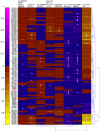Plasma lipid composition and risk of developing cardiovascular disease
- PMID: 23967253
- PMCID: PMC3744469
- DOI: 10.1371/journal.pone.0071846
Plasma lipid composition and risk of developing cardiovascular disease
Abstract
Aims: We tested whether characteristic changes of the plasma lipidome in individuals with comparable total lipids level associate with future cardiovascular disease (CVD) outcome and whether 23 validated gene variants associated with coronary artery disease (CAD) affect CVD associated lipid species.
Methods and results: Screening of the fasted plasma lipidome was performed by top-down shotgun analysis and lipidome compositions compared between incident CVD cases (n = 211) and controls (n = 216) from the prospective population-based MDC study using logistic regression adjusting for Framingham risk factors. Associations with incident CVD were seen for eight lipid species (0.21≤q≤0.23). Each standard deviation unit higher baseline levels of two lysophosphatidylcholine species (LPC), LPC16∶0 and LPC20∶4, was associated with a decreased risk for CVD (P = 0.024-0.028). Sphingomyelin (SM) 38∶2 was associated with increased odds of CVD (P = 0.057). Five triglyceride (TAG) species were associated with protection (P = 0.031-0.049). LPC16∶0 was negatively correlated with the carotid intima-media thickness (P = 0.010) and with HbA1c (P = 0.012) whereas SM38∶2 was positively correlated with LDL-cholesterol (P = 0.0*10(-6)) and the q-values were good (q≤0.03). The risk allele of 8 CAD-associated gene variants showed significant association with the plasma level of several lipid species. However, the q-values were high for many of the associations (0.015≤q≤0.75). Risk allele carriers of 3 CAD-loci had reduced level of LPC16∶0 and/or LPC 20∶4 (P≤0.056).
Conclusion: Our study suggests that CVD development is preceded by reduced levels of LPC16∶0, LPC20∶4 and some specific TAG species and by increased levels of SM38∶2. It also indicates that certain lipid species are intermediate phenotypes between genetic susceptibility and overt CVD. But it is a preliminary study that awaits replication in a larger population because statistical significance was lost for the associations between lipid species and future cardiovascular events when correcting for multiple testing.
Conflict of interest statement
Figures


References
-
- Greenland P, Knoll MD, Stamler J, Neaton JD, Dyer AR, et al. (2003) Major risk factors as antecedents of fatal and nonfatal coronary heart disease events. JAMA 290: 891–897. - PubMed
-
- Khot UN, Khot MB, Bajzer CT, Sapp SK, Ohman EM, et al. (2003) Prevalence of conventional risk factors in patients with coronary heart disease. JAMA 290: 898–904. - PubMed
-
- Wang TJ, Gona P, Larson MG, Tofler GH, Levy D, et al. (2006) Multiple biomarkers for the prediction of first major cardiovascular events and death. N Engl J Med 355: 2631–2639. - PubMed
Publication types
MeSH terms
Substances
LinkOut - more resources
Full Text Sources
Other Literature Sources
Miscellaneous

